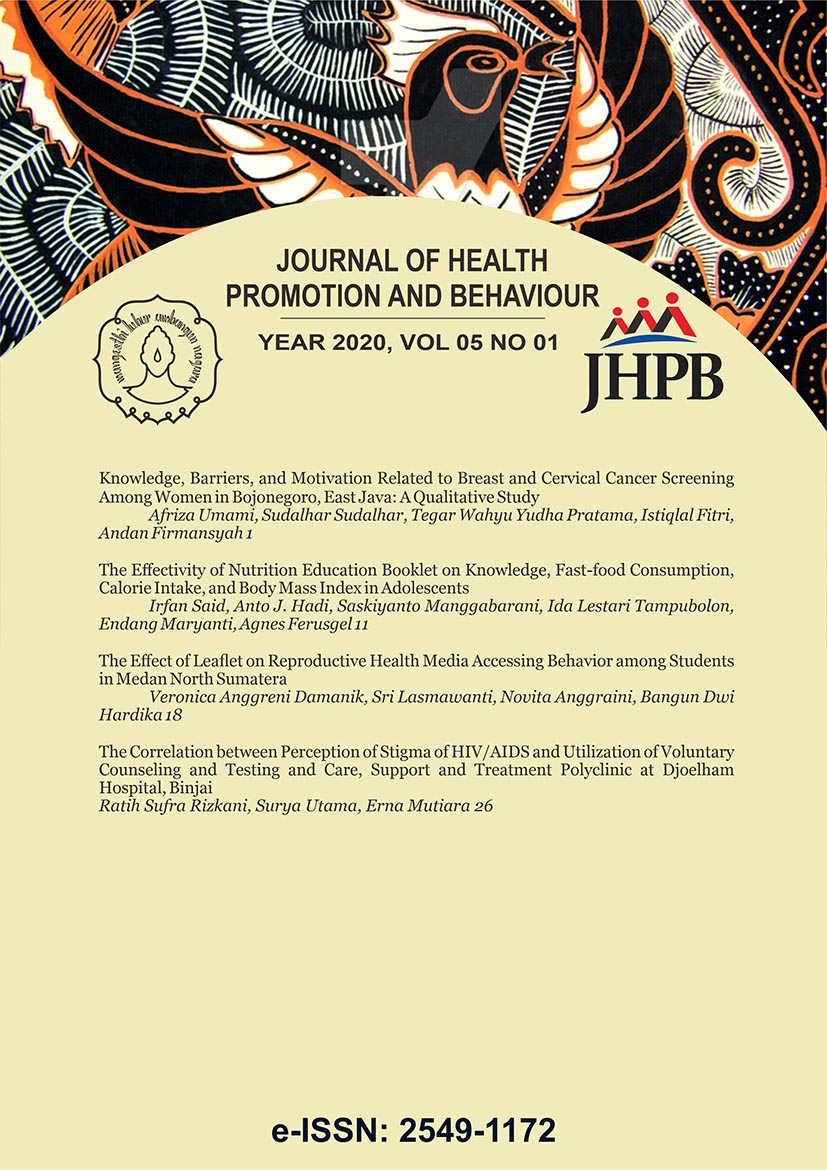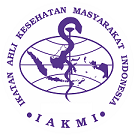The Effectivity of Peer Education Module on Knowledge, Attitude, and Fast Food Consumption in Adolescents
Abstract
Background: Increasing obesity sufferers every year, in a few decades becomes an important problem. Increased obesity can lead to an increased risk of degenerative diseases which can cause death. Several attempts have been made to prevent and treat obesity. The purpose of this study is to determine the effectiveness of peer education on knowledge, attitudes, and consumption of fast food in adolescents.
Subjects and Method: This study is a randomized controlled trial conducted at a Junior High School (SMP Negeri 6 Medan), North Sumatera. Samples taken were 60 students chosen randomly. The sample was divided into 2 groups: a peer game education leaflet group and a peer education module group. The dependent variable is knowledge, attitudes, and habits of fast food consumption. The independent variable is the provision of leaflets and peer education modules. The data were obtained through interview, Food Frequency Questionnaire (FFQ), and Food Recall 24 hours. Data were analyzed using t-test.
Results: The results showed that the value of nutritional knowledge and obesity in the control group (Mean= 12.07; SD= 1.44) was lower compared to the intervention group (Mean= 13.50; SD= 1.99), but not statistically significant (p= 0.523). Attitudes toward nutrition and obesity in the control group (Mean= 11.50; SD= 1.22) were lower than those in the intervention group (Mean = 13.00; SD= 1.78) and were statistically proven significant (p= 0.008). The score of fast food consumption habits in the control group (Mean= 8.17; SD= 1.23) is lower than that of the intervention group (Mean= 9.50; SD= 1.17) and is statistically proven significant (p <0.001).
Conclusion: The nutrition peer education module has been shown to be effective in increasing attitudes about nutrition and obesity and reducing fast food consumption habits and this has been statistically significant. The nutrition peer education module increases knowledge scores, but is not statistically significant.
Keywords: obesity, consumption of fast food, peer education
Correspondence: Saskiyanto Manggabarani, Helvetia Health Institute, Jl. Kapten Sumarsono No. 107 Medan, North Sumatera, Indonesia. Email: zhakymanggabarani@gmail.com.
Journal of Health Promotion and Behavior (2020), 5(1): 35-42
https://doi.org/10.26911/thejhpb.2020.05.01.05
References
Al-Hazzaa HM, Al-Sobayel HI, Abahussain NA, Qahwaji DM, Alahmadi MA, Mu-saiger AO (2014). Association of dietary habits with levels of physical activity and screen time among adolescents living in S audi A rabia. Journal of Human Nutrition and Dietetics, 27: 204–213. https://doi.org/10.1111/jhn.12147.
Alturki HA, Brookes DS, Davies PS (2018). Comparative evidence of the consumption from fastfood restaurants between normalweight and obese Saudi school children. Public Health Nutrition, 21(12): 2280–2290. https://doi.org/10.1017/S1368980018000757.
Bean MK, Ingersoll KS, Powell P, SternM, Evans RK, Wickham III EP, MazzeoSE (2018). Impact of motivational interviewing on outcomes of an adolescent obesity treatment: Results from the MI Values randomized controlled pilot trial. Clinical Obesity, 8(5): 323–326. https://doi.org/10.1111/cob.12257
Fahlman MM, McCaughtry N, Martin J, Shen B (2010). Racial and socioeconomic disparities in nutrition behaviors: Targeted interventions needed. Journal of Nutrition Education and Behavior, 42(1): 10–16. https://doi.org/10.1016/j.jneb.2008.11.003.
Hadi AJ, Hadju VS, Indriasari R, Manggabara S, Yetti RE, et al. (2019). The effect of the implementation of a planned peer group session model on obesity prevention among students of an Integrated Islamic primary school in Makassar. Pakistan Journal of Nutrition, 18(9): 882–887. https://doi.org/10.3923/pjn.2019.882.887.
Hatta H, Hadi AJ, Tombeg Z, Manggabarani S (2018). The relationship between food selection factors for students at Maccini Sombala Inpres Elementary School Makassar City. Window of Health: Jurnal Kesehatan, 355–363. https://doi.org/10.33368/woh.v1i4.112
Kant AK, Graubard BI (2013). Family income and education were related with 30year time trends in dietary and meal behaviors of American Children and Adolescents3. The Journal of Nutrition, 143(5): 690–700. https://doi.org/10.3945/jn.112.165258.
Lee HA, Lee WK, Kong KA, Chang N, Ha EH, Hong YS, Park H (2011). The effect of eating behavior on being overweight or obese during preadolescence. Int J Prev Med, 44(5): 226. https://doi.org/10.3961/jpmph.2011.44.5.226.
Lee HA, Park H (2013). Overview of noncommunicable diseases in Korean children and adolescents: Focus on obesity and its effect on metabolic syndrome. Journal of Preventive Medicine and Public Health, 46(4): 173. https://doi.org/10.3961/jpmph.2013.46.4.173.
Lobstein T, JacksonLeach R, Moodie ML, Hall KD, GortmakerSL, Swinburn BA, et al. (2015). Child and adolescent obesity: part of a bigger picture. The Lancet, 385(9986): 2510–2520. https://doi.org/10.1016/S01406736(14)617463.
Lubans DR, Smith JJ, Skinner G, Morgan PJ (2014). Development and implementation of a smartphone application to promote physical activity and reduce screen time in adolescent boys. Frontiers in Public Health, 2: 42. https://doi.org/10.3389/fpubh.2014.00042.
Nicholls L, Lewis AJ, PetersenS, Swinburn B, Moodie M, Millar L (2014). Parental encouragement of healthy behaviors. BMC Public Health, 14(1): 369. https://doi.org/10.1186/1471245814369.
Nickel F, Tapking C, Benner L, Schüler S, Ottawa GB, Krug K, et al. (2019). Video teaching leads to improved attitudes towards obesity a randomized study with 949 participants. Obesity Surgery, 29(7): 2078–2086. https://doi.org/10.1007/s11695019038049
Oyewande A, Ademola A, Okuneye T, Sanni F, Hassan A, Olaiya P (2019). Knowledge, attitude and Perception regarding risk factors of overweight and obesity among secondary school students in Ikeja Local Government Area, Nigeria. Journal of Family Medicine
and Primary Care, 8(4): 1391. https://doi.org/10.4103/jfmpc.jfmpc_160_19.
Roebroek YGM, Talib A, Muris JWM, van Dielen FMH, Bouvy ND, van Heurn LWE (2019). Hurdles to take for adequate treatment of morbidly obese children and adolescents. World Journal of Surgery, 43(4): 1173–1181. https://doi.org/10.1007/s0026801848745.
Ryu SY, Park J, Choi SW, Han MA (2014). Associations between sociodemographic characteristics and healthy lifestyles in Korean adults: The result of the 2010 community health survey. Journal of Preventive Medicine Public Health, 47(2): 113–123. https://doi.org/10.3961jpmph.2014.47.2.113
Shaban L, Alkazemi D (2019). Trends in fastfood consumption among Kuwaiti youth. International Journal of Preventive Medicine, 10. https://doi.org/10.4103/ijpvm.IJPVM_480_18.
Sousa P, Duarte E, Ferreira R, Esperança A, Frontini R, SantosRocha, et al. (2019). An mHealth intervention programme to promote healthy behaviours and prevent adolescent obesity (TeenPower): A study protocol. Journal of Advanced Nursing, 75(3): 683–691. https://doi.org/10.1111/jan.13905.
Steinbeck KS, Lister NB, Gow ML, Baur LA (2018). Treatment of adolescent obesity. Nature Reviews Endocrinology, 14(6): 331–344. https://doi.org/10.1038/s4157401800028.
Wang Y, Jahns L, TussingHumphreys L, Xie B, Rockett H, Liang H, Johnson L (2010). Dietary intake patterns of low income urban AfricanAmerican adolescents. J Am Diet Assoc, 110(9):13401345. https://doi.org/10.1016/j.jada.2010.06.005.
YackobovitchGavan M, Wolf Linhard D, Nagelberg N, Poraz I, Shalitin S, Phillip M, Meyerovitch J (2018). Intervention for childhood obesity based on parents only or parents and child compared with followup alone. Pediatric Obesity, 13(11): 647–655. https://doi.org/10.1111/ijpo.12263




